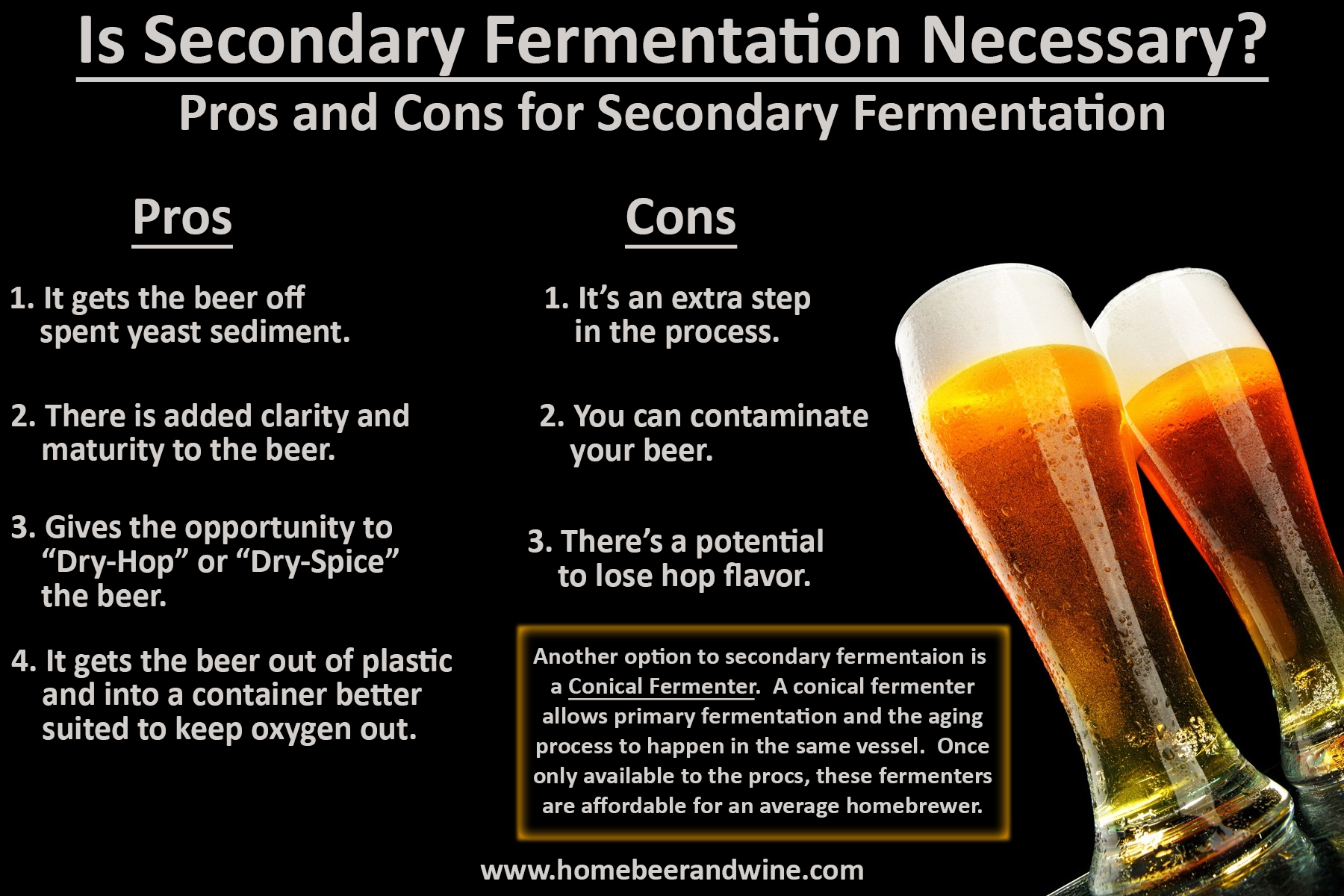Secondary fermentation is the process of taking beer from an initial fermentation bucket and transferring it to another container for additional aging. But is secondary fermentation necessary? There are pros and cons to secondary fermentation for your homebrew beer. In some cases it may not be necessary at all, but in other cases it may be vital to the beer.
Is Secondary Fermentation Necessary?
The Cons Of Secondary Fermentation
An Extra Step in the Process
This may be the most obvious con to secondary fermentation. But secondary fermentation will add one more extra thing for you to do during the weeks long process it takes to make beer. How long it takes to transfer the beer will depend on your setup. Usually the time it takes to transfer is much shorter than brew day or bottle day. If you choose to go with a single stage fermentation than your work is done between the time brew day ends and it’s time to bottle your beer.
You Can Contaminate Your Beer
By transferring your beer from one container to another you risk the addition of contaminants into the beer. As mentioned before, contaminants can be introduced from the environment around you or unsanitary equipment. As you open your fermenter and beer passes through a siphoning hose the risk of bacteria or wild yeast getting into your beer increases. Also, the risk of oxygen being introduced is a big risk in secondary fermentation. When oxygen is introduced into fermented beer it can lead to a cardboard-like or stale flavor. It adds to the cost since you need to buy an extra carboy. As long as all of your equipment is sanitized you should be fine.
Potential to Lose Hop Flavor
Hop flavors degrade over time. In most cases, a few weeks won’t make a difference, but if you’re brewing a very hop-forward beer, the length of the fermentation period should be considered. However, if you read the pros listed below secondary fermentation is a great time to add hop flavors or other spices back into the beer.
The Pros Of Secondary Fermentation
It gets the beer off spent yeast sediment
After two or three weeks, yeast starts to break down and contribute off flavors to your beer. Most homebrewers don’t ferment their beer long enough to cause any noticeably problems, but for those who choose to do a longer fermentation, racking the beer into a secondary fermenter or carboy is highly recommended. Unfortunately, when yeast uses up all of the sugars they don’t produce carbon dioxide and ethanol anymore. Instead, through a process known as “autolysis” they produce some interesting off flavors, reminiscent of burning tires-definitely something you don’t want in your beer.
Added Clarity and Maturity to the Beer
Clarity is increased by reducing the amount of sediment in the finished beer. Putting your beer through secondary fermentation allows time for more yeast, hop trub, and protein to fall out of the beer. The additional time also allows the malt, hops, and yeast flavors to blend together which creates a more flavorful beer. Adding a fining agent, such as gelatin, into the secondary fermenter can aid in this process significantly. In the end, you will have a better looking brew with less sediment in the bottom of the bottle.
Gives the Opportunity to “Dry-Hop” or “Dry-Spice” the Beer
Dry-hopping is just adding hops to the secondary fermenter. This contributes to the hop aroma of the beer. It’s also the opportune time to add any spices, flavorings, wood chips, or other additives to your brew. You will see this a lot for seasonal beers.
Get the Beer Out of Plastic
Plastic buckets are never fully air tight. Once the primary fermentation has slowed and is not producing large amounts of protective carbon dioxide oxygen will affect the beer. This is what will produce those stale and oxidized flavors. If we’re going to let the beer sit after its main fermentation is done it should be in glass, and away from the spent yeast that accumulates at the bottom of the primary fermenter.
The Other Option To Secondary Fermentation – Conical Fermentation
So now that we’ve discussed some of the pros and cons – is secondary fermentation necessary? The short answer is “no” secondary fermentation isn’t necessary. And overall, the risks of contamination and the introduction of oxygen outweigh the benefits. However, if you do have the right equipment and have some experience there are benefits to a secondary fermentation.
But there is another option to secondary fermentation. Nowadays, most craft and professional breweries use conical fermenters. Conical fermenters allow primary fermentation and aging in the same vessel. Once only available to the pros, these conical fermenters are now affordable and available to the homebrewer.
Is Secondary Fermentation Necessary? Final Thoughts…
So why age your beer for so long? The longer aging using secondary fermentation will generally smooth out the beer giving you a more pleasant tasting beer. Once your beer has cleared to your satisfaction in secondary fermentation it has probably also completed any biological benefits. So is secondary fermentation necessary and should you do it? Some brewers only do it for lagers, some only with their “big” beers, and some for nearly every beer, to help with the clarifying if nothing else. It’s just one more tool to help you make that perfect beer. If you have a conical fermenter than skip the secondary fermentation.


